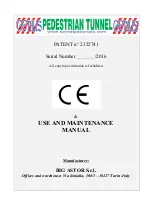
- 4 -
l
Do not attempt to operate defective equipment. Check that hoses
and fittings are in good condition.
l
Ensure maintenance procedures are carried out as specified.
l
Do not attempt to operate this equipment on a greater hydraulic
flow than that specified.
l
Before using the equipment check for underground cables. Note:
the breaker is not electrically insulated.
l
Be aware of the dangers of collapse when working close to banks
and in trenches.
l
Never allow the point of a steel to rest against or be facing the
direction of any part of the body.
l
Fine jets of hydraulic oil can penetrate the skin. Check for leaks by
holding a piece of cardboard near to the suspect area. If hydraulic
oil does penetrate the skin or is ingested seek medical help
immediately.
l
Never attempt to dismantle the pressure accumulator.
l
Always isolate hydraulic supply before making a disconnection or
connection.
l
Do not attempt to modify the equipment in any way. This could
result in a
dangerous product and will invalidate the warranty.
l
Always comply with local and site safety regulations.
l
When fitting and removing steels ensure the control valve at the
hydraulic supply is in the
‘
OFF
’
position. If no control valve is fitted
the engine must be stopped.
l
Never operate the breaker unless the steel is in contact with the
work piece.
l
Do not use steels that are worn at their shank. Blunted steels
should be
sharpened before use.



































